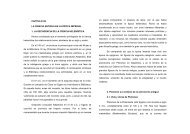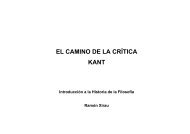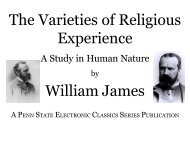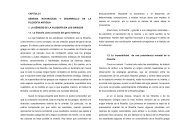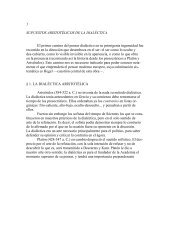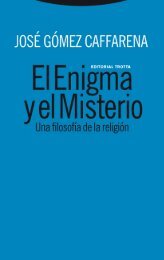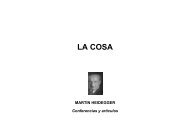- Page 2 and 3:
Routledge History of Philosophy Vol
- Page 4 and 5:
Routledge History of Philosophy Vol
- Page 6 and 7:
v 1. Philosophy, Renaissance. 2. Ph
- Page 8 and 9:
vii Glossary 389 Index of names 407
- Page 10 and 11:
element in learning about the natur
- Page 12 and 13:
J.G.Cottingham is Professor of Phil
- Page 14 and 15:
xiii Politics and Religion The Arts
- Page 16 and 17:
xv Politics and Religion The Arts 1
- Page 18 and 19:
xvii Politics and Religion The Arts
- Page 20 and 21:
xix Politics and Religion The Arts
- Page 22 and 23:
xxi Politics and Religion The Arts
- Page 24 and 25:
xxiii Politics and Religion The Art
- Page 26 and 27:
xxv Politics and Religion The Arts
- Page 28 and 29:
xxvii Politics and Religion The Art
- Page 30 and 31:
2 RENAISSANCE AND SEVENTEENTH-CENTU
- Page 32 and 33:
4 RENAISSANCE AND SEVENTEENTH-CENTU
- Page 34 and 35:
6 RENAISSANCE AND SEVENTEENTH-CENTU
- Page 36 and 37:
8 RENAISSANCE AND SEVENTEENTH-CENTU
- Page 38 and 39:
10 RENAISSANCE AND SEVENTEENTH-CENT
- Page 40 and 41:
12 RENAISSANCE AND SEVENTEENTH-CENT
- Page 42 and 43:
14 RENAISSANCE AND SEVENTEENTH-CENT
- Page 44 and 45:
16 THE PHILOSOPHY OF THE ITALIAN RE
- Page 46 and 47:
18 THE PHILOSOPHY OF THE ITALIAN RE
- Page 48 and 49:
20 THE PHILOSOPHY OF THE ITALIAN RE
- Page 50 and 51:
22 THE PHILOSOPHY OF THE ITALIAN RE
- Page 52 and 53:
24 THE PHILOSOPHY OF THE ITALIAN RE
- Page 54 and 55:
26 THE PHILOSOPHY OF THE ITALIAN RE
- Page 56 and 57:
28 THE PHILOSOPHY OF THE ITALIAN RE
- Page 58 and 59:
30 THE PHILOSOPHY OF THE ITALIAN RE
- Page 60 and 61:
32 THE PHILOSOPHY OF THE ITALIAN RE
- Page 62 and 63:
34 THE PHILOSOPHY OF THE ITALIAN RE
- Page 64 and 65:
36 THE PHILOSOPHY OF THE ITALIAN RE
- Page 66 and 67:
38 THE PHILOSOPHY OF THE ITALIAN RE
- Page 68 and 69:
40 THE PHILOSOPHY OF THE ITALIAN RE
- Page 70 and 71:
42 THE PHILOSOPHY OF THE ITALIAN RE
- Page 72 and 73:
44 THE PHILOSOPHY OF THE ITALIAN RE
- Page 74 and 75:
46 THE PHILOSOPHY OF THE ITALIAN RE
- Page 76 and 77:
48 THE PHILOSOPHY OF THE ITALIAN RE
- Page 78 and 79:
50 THE PHILOSOPHY OF THE ITALIAN RE
- Page 80 and 81:
52 THE PHILOSOPHY OF THE ITALIAN RE
- Page 82 and 83:
54 THE PHILOSOPHY OF THE ITALIAN RE
- Page 84 and 85:
56 THE PHILOSOPHY OF THE ITALIAN RE
- Page 86 and 87:
58 THE PHILOSOPHY OF THE ITALIAN RE
- Page 88 and 89:
60 THE PHILOSOPHY OF THE ITALIAN RE
- Page 90 and 91:
62 THE PHILOSOPHY OF THE ITALIAN RE
- Page 92 and 93:
64 THE PHILOSOPHY OF THE ITALIAN RE
- Page 94 and 95:
66 RENAISSANCE PHILOSOPHY OUTSIDE I
- Page 96 and 97:
68 RENAISSANCE PHILOSOPHY OUTSIDE I
- Page 98 and 99:
70 RENAISSANCE PHILOSOPHY OUTSIDE I
- Page 100 and 101:
72 RENAISSANCE PHILOSOPHY OUTSIDE I
- Page 102 and 103:
74 RENAISSANCE PHILOSOPHY OUTSIDE I
- Page 104 and 105:
76 RENAISSANCE PHILOSOPHY OUTSIDE I
- Page 106 and 107:
78 RENAISSANCE PHILOSOPHY OUTSIDE I
- Page 108 and 109:
80 RENAISSANCE PHILOSOPHY OUTSIDE I
- Page 110 and 111:
82 RENAISSANCE PHILOSOPHY OUTSIDE I
- Page 112 and 113:
84 RENAISSANCE PHILOSOPHY OUTSIDE I
- Page 114 and 115:
86 RENAISSANCE PHILOSOPHY OUTSIDE I
- Page 116 and 117:
88 RENAISSANCE PHILOSOPHY OUTSIDE I
- Page 118 and 119:
90 RENAISSANCE PHILOSOPHY OUTSIDE I
- Page 120 and 121:
92 RENAISSANCE PHILOSOPHY OUTSIDE I
- Page 122 and 123:
94 RENAISSANCE PHILOSOPHY OUTSIDE I
- Page 124 and 125:
96 RENAISSANCE PHILOSOPHY OUTSIDE I
- Page 126 and 127:
98 SCIENCE AND MATHEMATICS UP TO DE
- Page 128 and 129:
100 SCIENCE AND MATHEMATICS UP TO D
- Page 130 and 131:
102 SCIENCE AND MATHEMATICS UP TO D
- Page 132 and 133:
104 SCIENCE AND MATHEMATICS UP TO D
- Page 134 and 135:
106 SCIENCE AND MATHEMATICS UP TO D
- Page 136 and 137:
108 SCIENCE AND MATHEMATICS UP TO D
- Page 138 and 139:
110 SCIENCE AND MATHEMATICS UP TO D
- Page 140 and 141:
112 SCIENCE AND MATHEMATICS UP TO D
- Page 142 and 143:
114 SCIENCE AND MATHEMATICS UP TO D
- Page 144 and 145:
116 SCIENCE AND MATHEMATICS UP TO D
- Page 146 and 147:
118 SCIENCE AND MATHEMATICS UP TO D
- Page 148 and 149:
120 SCIENCE AND MATHEMATICS UP TO D
- Page 150 and 151:
122 SCIENCE AND MATHEMATICS UP TO D
- Page 152 and 153:
124 SCIENCE AND MATHEMATICS UP TO D
- Page 154 and 155:
126 SCIENCE AND MATHEMATICS UP TO D
- Page 156 and 157:
128 SCIENCE AND MATHEMATICS UP TO D
- Page 158 and 159:
CHAPTER 4 Francis Bacon and man’s
- Page 160 and 161:
132 FRANCIS BACON AND MAN’S TWO-F
- Page 162 and 163:
134 FRANCIS BACON AND MAN’S TWO-F
- Page 164 and 165:
136 FRANCIS BACON AND MAN’S TWO-F
- Page 166 and 167:
138 FRANCIS BACON AND MAN’S TWO-F
- Page 168 and 169:
140 FRANCIS BACON AND MAN’S TWO-F
- Page 170 and 171:
142 FRANCIS BACON AND MAN’S TWO-F
- Page 172 and 173:
144 FRANCIS BACON AND MAN’S TWO-F
- Page 174 and 175:
146 FRANCIS BACON AND MAN’S TWO-F
- Page 176 and 177:
148 FRANCIS BACON AND MAN’S TWO-F
- Page 178 and 179:
150 FRANCIS BACON AND MAN’S TWO-F
- Page 180 and 181:
152 FRANCIS BACON AND MAN’S TWO-F
- Page 182 and 183:
154 FRANCIS BACON AND MAN’S TWO-F
- Page 184 and 185:
CHAPTER 5 Descartes: methodology St
- Page 186 and 187:
158 RENAISSANCE AND SEVENTEENTH-CEN
- Page 188 and 189:
160 RENAISSANCE AND SEVENTEENTH-CEN
- Page 190 and 191:
162 RENAISSANCE AND SEVENTEENTH-CEN
- Page 192 and 193:
164 RENAISSANCE AND SEVENTEENTH-CEN
- Page 194 and 195:
166 RENAISSANCE AND SEVENTEENTH-CEN
- Page 196 and 197:
168 RENAISSANCE AND SEVENTEENTH-CEN
- Page 198 and 199:
170 RENAISSANCE AND SEVENTEENTH-CEN
- Page 200 and 201:
172 RENAISSANCE AND SEVENTEENTH-CEN
- Page 202 and 203:
174 RENAISSANCE AND SEVENTEENTH-CEN
- Page 204 and 205:
176 RENAISSANCE AND SEVENTEENTH-CEN
- Page 206 and 207:
178 RENAISSANCE AND SEVENTEENTH-CEN
- Page 208 and 209:
180 RENAISSANCE AND SEVENTEENTH-CEN
- Page 210 and 211: 182 RENAISSANCE AND SEVENTEENTH-CEN
- Page 212 and 213: 184 RENAISSANCE AND SEVENTEENTH-CEN
- Page 214 and 215: 186 RENAISSANCE AND SEVENTEENTH-CEN
- Page 216 and 217: 188 RENAISSANCE AND SEVENTEENTH-CEN
- Page 218 and 219: 190 RENAISSANCE AND SEVENTEENTH-CEN
- Page 220 and 221: 192 RENAISSANCE AND SEVENTEENTH-CEN
- Page 222 and 223: 194 RENAISSANCE AND SEVENTEENTH-CEN
- Page 224 and 225: 196 RENAISSANCE AND SEVENTEENTH-CEN
- Page 226 and 227: 198 RENAISSANCE AND SEVENTEENTH-CEN
- Page 228 and 229: 200 RENAISSANCE AND SEVENTEENTH-CEN
- Page 230 and 231: 202 RENAISSANCE AND SEVENTEENTH-CEN
- Page 232 and 233: 204 RENAISSANCE AND SEVENTEENTH-CEN
- Page 234 and 235: 206 RENAISSANCE AND SEVENTEENTH-CEN
- Page 236 and 237: 208 RENAISSANCE AND SEVENTEENTH-CEN
- Page 238 and 239: 210 RENAISSANCE AND SEVENTEENTH-CEN
- Page 240 and 241: 212 RENAISSANCE AND SEVENTEENTH-CEN
- Page 242 and 243: 214 RENAISSANCE AND SEVENTEENTH-CEN
- Page 244 and 245: 216 RENAISSANCE AND SEVENTEENTH-CEN
- Page 246 and 247: 218 RENAISSANCE AND SEVENTEENTH-CEN
- Page 248 and 249: 220 RENAISSANCE AND SEVENTEENTH-CEN
- Page 250 and 251: 222 RENAISSANCE AND SEVENTEENTH-CEN
- Page 252 and 253: 224 RENAISSANCE AND SEVENTEENTH-CEN
- Page 254 and 255: 226 RENAISSANCE AND SEVENTEENTH-CEN
- Page 256 and 257: 228 RENAISSANCE AND SEVENTEENTH-CEN
- Page 258 and 259: 230 RENAISSANCE AND SEVENTEENTH-CEN
- Page 262 and 263: 234 RENAISSANCE AND SEVENTEENTH-CEN
- Page 264 and 265: 236 RENAISSANCE AND SEVENTEENTH-CEN
- Page 266 and 267: 238 RENAISSANCE AND SEVENTEENTH-CEN
- Page 268 and 269: 240 RENAISSANCE AND SEVENTEENTH-CEN
- Page 270 and 271: 242 RENAISSANCE AND SEVENTEENTH-CEN
- Page 272 and 273: 244 RENAISSANCE AND SEVENTEENTH-CEN
- Page 274 and 275: 246 RENAISSANCE AND SEVENTEENTH-CEN
- Page 276 and 277: 248 RENAISSANCE AND SEVENTEENTH-CEN
- Page 278 and 279: 250 RENAISSANCE AND SEVENTEENTH-CEN
- Page 280 and 281: 252 RENAISSANCE AND SEVENTEENTH-CEN
- Page 282 and 283: 254 RENAISSANCE AND SEVENTEENTH-CEN
- Page 284 and 285: 256 RENAISSANCE AND SEVENTEENTH-CEN
- Page 286 and 287: 258 RENAISSANCE AND SEVENTEENTH-CEN
- Page 288 and 289: 260 RENAISSANCE AND SEVENTEENTH-CEN
- Page 290 and 291: 262 RENAISSANCE AND SEVENTEENTH-CEN
- Page 292 and 293: 264 RENAISSANCE AND SEVENTEENTH-CEN
- Page 294 and 295: 266 RENAISSANCE AND SEVENTEENTH-CEN
- Page 296 and 297: 268 RENAISSANCE AND SEVENTEENTH-CEN
- Page 298 and 299: 270 RENAISSANCE AND SEVENTEENTH-CEN
- Page 300 and 301: 272 RENAISSANCE AND SEVENTEENTH-CEN
- Page 302 and 303: 274 RENAISSANCE AND SEVENTEENTH-CEN
- Page 304 and 305: 276 RENAISSANCE AND SEVENTEENTH-CEN
- Page 306 and 307: 278 RENAISSANCE AND SEVENTEENTH-CEN
- Page 308 and 309: 280 RENAISSANCE AND SEVENTEENTH-CEN
- Page 310 and 311:
282 RENAISSANCE AND SEVENTEENTH-CEN
- Page 312 and 313:
284 RENAISSANCE AND SEVENTEENTH-CEN
- Page 314 and 315:
286 RENAISSANCE AND SEVENTEENTH-CEN
- Page 316 and 317:
CHAPTER 9 The moral and political p
- Page 318 and 319:
290 RENAISSANCE AND SEVENTEENTH-CEN
- Page 320 and 321:
292 RENAISSANCE AND SEVENTEENTH-CEN
- Page 322 and 323:
294 RENAISSANCE AND SEVENTEENTH-CEN
- Page 324 and 325:
296 RENAISSANCE AND SEVENTEENTH-CEN
- Page 326 and 327:
298 RENAISSANCE AND SEVENTEENTH-CEN
- Page 328 and 329:
300 RENAISSANCE AND SEVENTEENTH-CEN
- Page 330 and 331:
302 RENAISSANCE AND SEVENTEENTH-CEN
- Page 332 and 333:
304 RENAISSANCE AND SEVENTEENTH-CEN
- Page 334 and 335:
306 RENAISSANCE AND SEVENTEENTH-CEN
- Page 336 and 337:
308 RENAISSANCE AND SEVENTEENTH-CEN
- Page 338 and 339:
310 RENAISSANCE AND SEVENTEENTH-CEN
- Page 340 and 341:
312 RENAISSANCE AND SEVENTEENTH-CEN
- Page 342 and 343:
314 RENAISSANCE AND SEVENTEENTH-CEN
- Page 344 and 345:
316 RENAISSANCE AND SEVENTEENTH-CEN
- Page 346 and 347:
318 RENAISSANCE AND SEVENTEENTH-CEN
- Page 348 and 349:
CHAPTER 10 Occasionalism Daisie Rad
- Page 350 and 351:
322 RENAISSANCE AND SEVENTEENTH-CEN
- Page 352 and 353:
324 RENAISSANCE AND SEVENTEENTH-CEN
- Page 354 and 355:
326 RENAISSANCE AND SEVENTEENTH-CEN
- Page 356 and 357:
328 RENAISSANCE AND SEVENTEENTH-CEN
- Page 358 and 359:
330 RENAISSANCE AND SEVENTEENTH-CEN
- Page 360 and 361:
332 RENAISSANCE AND SEVENTEENTH-CEN
- Page 362 and 363:
334 RENAISSANCE AND SEVENTEENTH-CEN
- Page 364 and 365:
336 RENAISSANCE AND SEVENTEENTH-CEN
- Page 366 and 367:
338 RENAISSANCE AND SEVENTEENTH-CEN
- Page 368 and 369:
340 RENAISSANCE AND SEVENTEENTH-CEN
- Page 370 and 371:
342 RENAISSANCE AND SEVENTEENTH-CEN
- Page 372 and 373:
344 RENAISSANCE AND SEVENTEENTH-CEN
- Page 374 and 375:
346 RENAISSANCE AND SEVENTEENTH-CEN
- Page 376 and 377:
348 RENAISSANCE AND SEVENTEENTH-CEN
- Page 378 and 379:
350 RENAISSANCE AND SEVENTEENTH-CEN
- Page 380 and 381:
352 RENAISSANCE AND SEVENTEENTH-CEN
- Page 382 and 383:
354 LEIBNIZ: TRUTH, KNOWLEDGE AND M
- Page 384 and 385:
356 LEIBNIZ: TRUTH, KNOWLEDGE AND M
- Page 386 and 387:
358 LEIBNIZ: TRUTH, KNOWLEDGE AND M
- Page 388 and 389:
360 LEIBNIZ: TRUTH, KNOWLEDGE AND M
- Page 390 and 391:
362 LEIBNIZ: TRUTH, KNOWLEDGE AND M
- Page 392 and 393:
364 LEIBNIZ: TRUTH, KNOWLEDGE AND M
- Page 394 and 395:
366 LEIBNIZ: TRUTH, KNOWLEDGE AND M
- Page 396 and 397:
368 LEIBNIZ: TRUTH, KNOWLEDGE AND M
- Page 398 and 399:
370 LEIBNIZ: TRUTH, KNOWLEDGE AND M
- Page 400 and 401:
372 LEIBNIZ: TRUTH, KNOWLEDGE AND M
- Page 402 and 403:
374 LEIBNIZ: TRUTH, KNOWLEDGE AND M
- Page 404 and 405:
376 LEIBNIZ: TRUTH, KNOWLEDGE AND M
- Page 406 and 407:
378 LEIBNIZ: TRUTH, KNOWLEDGE AND M
- Page 408 and 409:
380 LEIBNIZ: TRUTH, KNOWLEDGE AND M
- Page 410 and 411:
382 LEIBNIZ: TRUTH, KNOWLEDGE AND M
- Page 412 and 413:
384 LEIBNIZ: TRUTH, KNOWLEDGE AND M
- Page 414 and 415:
386 LEIBNIZ: TRUTH, KNOWLEDGE AND M
- Page 416 and 417:
388 LEIBNIZ: TRUTH, KNOWLEDGE AND M
- Page 418 and 419:
390 GLOSSARY attribute: Averroism:
- Page 420 and 421:
392 GLOSSARY compositio: a Latin ve
- Page 422 and 423:
394 GLOSSARY disposition: double as
- Page 424 and 425:
396 GLOSSARY gnoseology: habitus: H
- Page 426 and 427:
398 GLOSSARY induction, eliminative
- Page 428 and 429:
400 GLOSSARY modus tollens: monad:
- Page 430 and 431:
402 GLOSSARY Organon: pantheism: pa
- Page 432 and 433:
404 GLOSSARY Remonstrants: resoluti
- Page 434 and 435:
406 GLOSSARY truth, double: truth,
- Page 436 and 437:
408 INDEX OF NAMES Ceredi, Giuseppe
- Page 438 and 439:
410 INDEX OF NAMES Plato 6, 20, 29,
- Page 440 and 441:
412 INDEX OF SUBJECTS cogito ergo s
- Page 442 and 443:
414 INDEX OF SUBJECTS civil 264, 33
- Page 444:
416 INDEX OF SUBJECTS Descartes’


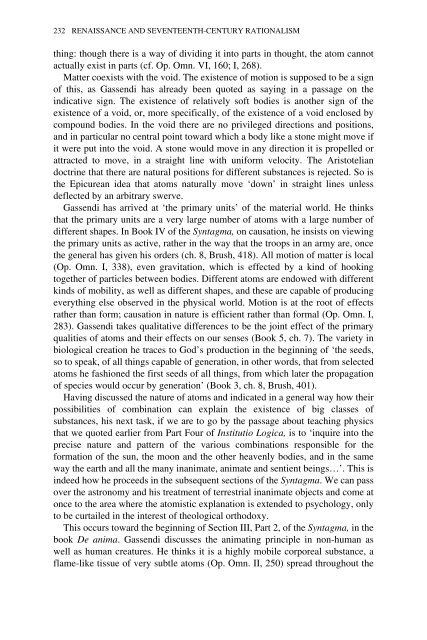
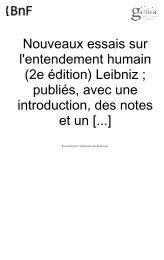

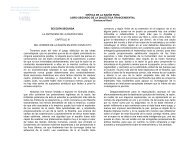


![Emile ou De l'ducation [Document lectronique] / Jean-Jacques ...](https://img.yumpu.com/51194314/1/190x245/emile-ou-de-lducation-document-lectronique-jean-jacques-.jpg?quality=85)
